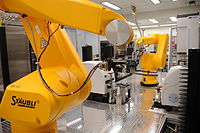
Getting the whole picture: High content screening using three‐dimensional cellular model systems and whole animal assays
Sign Up to like & getrecommendations! Published in 2017 at "Cytometry Part A"
DOI: 10.1002/cyto.a.22907
Abstract: Phenotypic or High Content Screening (HCS) is becoming more widely used for primary screening campaigns in drug discovery. Currently the vast majority of HCS campaigns are using cell lines grown in well‐established monolayer cultures (2D… read more here.
Keywords: animal assays; tissue culture; whole animal; content screening ... See more keywords

High Content Screening of Mammalian Primary Cortical Neurons.
Sign Up to like & getrecommendations! Published in 2018 at "Methods in molecular biology"
DOI: 10.1007/978-1-4939-7357-6_17
Abstract: High Content Screening (HCS) can be used to analyze the morphology of neuronal primary cultures on a large scale. When used in the field of neuronal regeneration this approach allows the screening of hundreds or… read more here.
Keywords: content screening; primary cortical; mammalian primary; screening mammalian ... See more keywords

Novel therapeutic drug identification and gene correlation for fatty liver disease using high‐content screening: Proof of concept
Sign Up to like & getrecommendations! Published in 2018 at "European Journal of Pharmaceutical Sciences"
DOI: 10.1016/j.ejps.2018.05.018
Abstract: &NA; Non‐alcoholic fatty liver disease (NAFLD) is a problem in obese people caused by increasing intake of high‐calorie food such as fructose implicated in the elevated prevalence. It is necessary to identify novel drugs to… read more here.
Keywords: fatty liver; disease; content screening; proof concept ... See more keywords

Assessment of genotoxicity of four volatile pollutants from cigarette smoke based on the in vitro γH2AX assay using high content screening.
Sign Up to like & getrecommendations! Published in 2017 at "Environmental toxicology and pharmacology"
DOI: 10.1016/j.etap.2017.07.005
Abstract: To evaluate the genotoxic effects of formaldehyde, acetaldehyde, acrolein and benzene on A549 cells, the in vitro γH2AX assay was used in combination with high content screening (HCS) technology. All aldehydes showed a significant genotoxicity… read more here.
Keywords: vitro h2ax; h2ax; h2ax assay; genotoxicity ... See more keywords

RNA fluorescence in situ hybridization for high-content screening.
Sign Up to like & getrecommendations! Published in 2017 at "Methods"
DOI: 10.1016/j.ymeth.2017.07.005
Abstract: Single molecule RNA imaging using fluorescent in situ hybridization (FISH) can provide quantitative information on mRNA abundance and localization in a single cell. There is now a growing interest in screening for modifiers of RNA… read more here.
Keywords: microscopy; rna; content screening; high content ... See more keywords

Validation of a Multiparametric, High-Content-Screening Assay for Predictive/Investigative Cytotoxicity: Evidence from Technology Transfer Studies and Literature Review.
Sign Up to like & getrecommendations! Published in 2017 at "Chemical research in toxicology"
DOI: 10.1021/acs.chemrestox.6b00403
Abstract: A multiparametric, live-cell, high-content-screening (HCS) cytotoxicity assay was first demonstrated in 2006 ( Arch. Toxicol. 2006 , 80 , 580 - 604 ) to be highly concordant with human hepatotoxicity, including idiosyncratic hepatotoxicities and other… read more here.
Keywords: high content; content screening; cytotoxicity; cell ... See more keywords

High-Content Screening Discovers Microplastics Released by Contact Lenses under Sunlight.
Sign Up to like & getrecommendations! Published in 2023 at "Environmental science & technology"
DOI: 10.1021/acs.est.3c01601
Abstract: The widespread use of plastic products leads to the ubiquity of microplastics in daily life, while the release of microplastics from long-used contact lenses has not been reported due to the limitations of conventional detection… read more here.
Keywords: released contact; contact lenses; contact; content screening ... See more keywords

High-Content Screening Pipeline for Natural Products Targeting Oncogenic Signaling in Melanoma.
Sign Up to like & getrecommendations! Published in 2022 at "Journal of natural products"
DOI: 10.1021/acs.jnatprod.1c01154
Abstract: The incidence of melanoma, the most fatal dermatological cancer, has dramatically increased over the last few decades. Modern targeted therapy with kinase inhibitors induces potent clinical responses, but drug resistance quickly develops. Combination therapy improves… read more here.
Keywords: signaling melanoma; high content; melanoma; activity ... See more keywords

Localization-based super-resolution imaging meets high-content screening
Sign Up to like & getrecommendations! Published in 2017 at "Nature Methods"
DOI: 10.1038/nmeth.4486
Abstract: Single-molecule localization microscopy techniques have proven to be essential tools for quantitatively monitoring biological processes at unprecedented spatial resolution. However, these techniques are very low throughput and are not yet compatible with fully automated, multiparametric… read more here.
Keywords: resolution; microscopy; super resolution; content screening ... See more keywords

High content screening identifies monensin as an EMT-selective cytotoxic compound
Sign Up to like & getrecommendations! Published in 2019 at "Scientific Reports"
DOI: 10.1038/s41598-018-38019-y
Abstract: Epithelial-to-mesenchymal transition (EMT) is implicated in cancer metastasis and drug resistance. Specifically targeting cancer cells in an EMT-like state may have therapeutic value. In this study, we developed a cell imaging-based high-content screening protocol to… read more here.
Keywords: emt selective; cytotoxic; selective cytotoxic; content screening ... See more keywords

A High-Content Screening Technology for Quantitatively Studying Podocyte Dynamics.
Sign Up to like & getrecommendations! Published in 2017 at "Advances in chronic kidney disease"
DOI: 10.1053/j.ackd.2017.04.001
Abstract: Podocytes form the visceral layer of a kidney glomerulus and express a characteristic octopus-like cellular architecture specialized for the ultrafiltration of blood. The cytoskeletal dynamics and structural elasticity of podocytes rely on the self-organization of… read more here.
Keywords: screening technology; high content; podocyte; content screening ... See more keywords